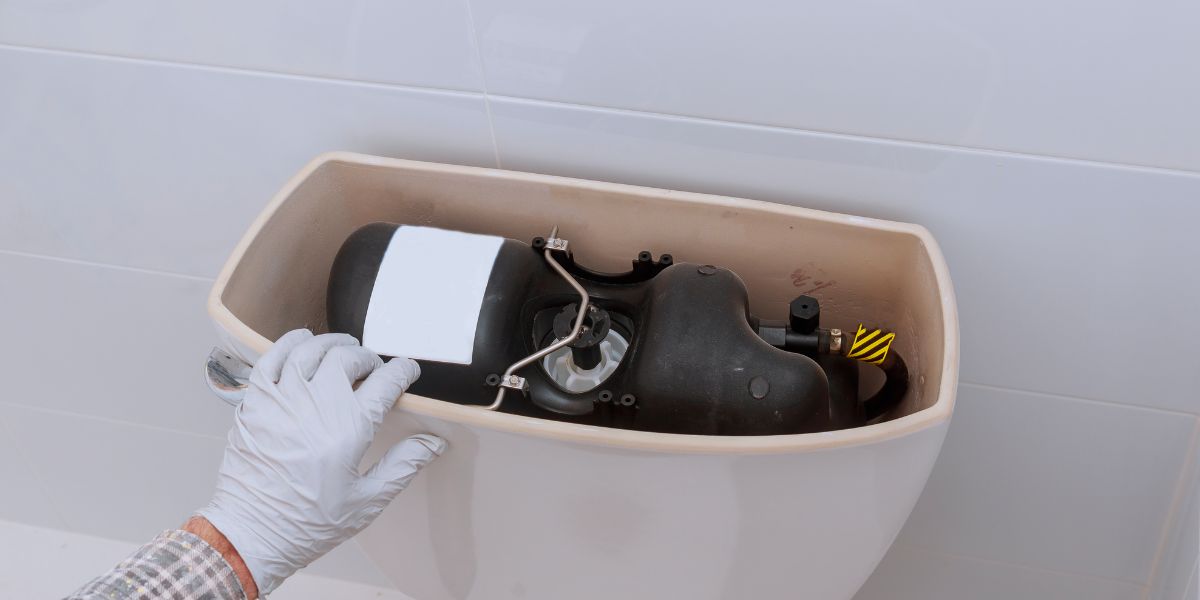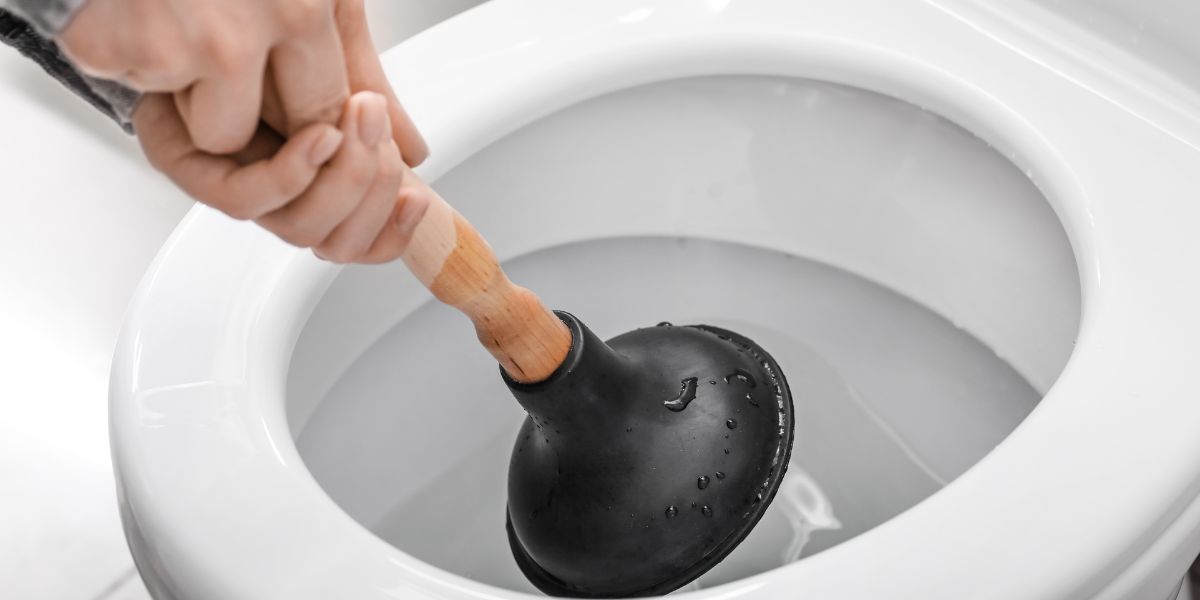Is your toilet bowl water level low than usual? Don’t worry, you’re not alone. It’s a common issue that many homeowners encounter, and the good news is that it’s usually something you can fix.
In this guide, I’ll walk you through the reasons why your toilet bowl water level might be low and how to tackle each of these issues like a pro.
How to Adjust the Water Level in a Toilet Bowl
Often times, the problem with a toilet bowl having a low amount of water is just a simple adjustment away. Perhaps the reason for low water level in your toilet bowl is because the float may have been set too low, preventing the tank from filling up adequately after each flush.
Adjusting the water level in your toilet bowl is a straightforward task that can make a significant difference in the efficiency and performance of your toilet. Whether you’ve noticed that the water level is too low, too high, adjusting the level of water in a toilet bowl is easy.
Why Adjust the Water Level in Your Toilet Bowl?
Before we jump into the fixing part, it is important to identify the problems and reasons your toilet water level is low.
There are many ways to adjust the water level of your toilet tank, but you might wonder why adjusting the water in your toilet matters. Well, there are several good reasons:
- Efficient Flushing: Proper toilet water levels are essential for efficient flushing. If the water level in a toilet bowl is too low or your toilet does not have enough water in the tank, the toilet may struggle to remove waste effectively, leading to frequent clogs. Conversely, if the water in the toilet bowl is too much, you’re wasting water with each flush. When you flush your toilet the right water level ensures a powerful and effective removal of waste while maintaining water conservation.
- Lowers Water Bill: If you use the right amount of water from the tank, this ensures that you’re using only what’s necessary to flush. This is not only environmentally friendly but can also lead to cost savings on your water bill.
- Preventing Splash: When the water level is too high, you might experience splashback during a flush. Adjusting it to the correct level can help avoid this unpleasant surprise.
Now that we understand the importance, let’s get into the nitty-gritty of adjusting your toilet’s water level.
Step-by-Step Guide to Adjusting Your Toilet Water Level

Whether you’re addressing a running toilet or optimizing water usage, adjusting the water level is crucial. With that said, I will help you set the right water level for efficient and eco-friendly flushing.
1. Turn off the Water Supply:
Before making any adjustments, it’s crucial to turn off any hose that connects to the water supply to your toilet. Locate the shut-off valve, usually found on the wall behind or beside the toilet. Turn it clockwise until it’s fully closed. This ensures that no water flows into the tank during the adjustment process.
2. Remove the Tank Lid:
Behind your toilet, you will find the toilet’s tank, lift the lid off the toilet tank and set it aside in a safe place. Be careful while doing this, as tank lids can be heavy and fragile.
3. Adjust the Float:
Inside the toilet tank, you’ll see a float mechanism. This controls the amount of water stored in your tank. There are typically two types of floats: ball floats and cup floats.
- Ball Float: If you have a ball float, you can adjust the water level by turning the screw on top of the fill valve. Turning it clockwise will lower the water level, and turning it counterclockwise will raise it. Flush the toilet and observe the water level to ensure it’s where you want it to be.
- Cup Float: For cup floats, you’ll often find an adjustment clip on the float rod. Moving the clip upwards will raise the water level, while moving it downward will lower it. Again, flush the toilet to test the new water level.
4. Test and Fine-Tune:
After making the adjustments, turn on the water supply valve counter- clockwise to raise the water and add water in your toilet bowl, then, flush the toilet a few times to ensure the water level is consistent and satisfactory. You may need to repeat steps 3 and 4 to fine-tune the water level until you fix the issue.
5. Turn the Water Supply Back On:
Once you’re satisfied with the water level, turn the valve on by turning the shut-off valve counterclockwise. This will allow water to flow into the tank and refill it to the adjusted level.
6. Replace the Tank Lid:
Carefully place the tank lid back onto the top of the toilet tank. Make sure it’s secure but don’t overtighten it.
The Reason and Cause of Your Toilet Bowl Water Level Low

Does your toilet keep clogging? It may be because your toilet’s water level could be too low. There are several potential culprits and common reasons causing your toilet bowl water level to be low, we’ll explore each of them in detail:
1. Water Tank Problems
A common reason your toilet bowl has low water is when the tank behind it doesn’t fill up enough. Inside your toilet tank, there’s a mechanism that controls the flow of water when your toilet is flushed. If this mechanism is malfunctioning, it can result in inadequate water entering the bowl.
Fix the Toilet Tank Mechanism:
Start by removing the lid off of the toilet tank and inspect the components within the toilet tank. Check if the fill valve is functioning correctly and if the toilet flapper is sealing properly after a flush. If you notice any issues, replace the faulty parts to restore proper water flow.
2. Clogged Inlet Holes
The inlet holes are small openings located around the rim of your toilet bowl, just below the seat. These holes allow water to flow into the bowl during a flush, creating the swirling action that helps clean the bowl. Over time, these holes can get clogged with mineral deposits and debris, restricting water flow. Here’s how to deal with this:
Fixing Inlet Holes:
Use a thin, flexible wire or a small brush to carefully clean out the inlet holes. Be gentle to avoid damaging the porcelain. Once the holes are clear, flush the toilet to see if the water level improves.
3. Blockage in The Vent Pipes
Your toilet is connected to a network of vent pipes that help maintain proper pressure in the plumbing system. If these vent pipes become blocked, it can interfere with the flushing and refilling process, causing low water levels in the bowl.
Fixing Vent Pipes Blockage:
Locate the vent pipe on your roof, and carefully inspect it for any obstructions, such as leaves or debris. Use a plumbing snake or a high-pressure hose to clear the blockage. Once the vent pipe is clear, your toilet’s water flow should return to normal.
4. Toilet Bowl Partial or Full Clog
A clog within the toilet bowl itself can also lead to a low water level. If there’s a blockage in the trap or further down the drainpipe, water won’t be able to flow into the bowl properly.
Fixing a Partial or Full Clog:
To clear a clog, you can use a plunger or a toilet auger. Place the plunger over the drain hole and apply firm, even pressure to create suction. If that doesn’t work, an auger can help break up and remove the clog. Once the blockage is gone, your toilet should flush and fill correctly.
5. Cracks in Toilet Bowl and Pipes
In some cases, cracks or leaks in the toilet bowl or the pipes connected to it can lead to a lesser water level. This issue is a bit trickier to fix on your own, as it may require professional help. Signs of a crack include visible water leaks around the base of the toilet or water escaping from the pipes. If you suspect this is the issue, it’s best to call in a plumber.
When to Call a Toilet Repair Professional
Toilet problems can be frustrating. Sometimes, the bowl doesn’t fill, or the water level acts weird. We even face moments when we’re unsure if the toilet will flush properly.
Don’t waste time overthinking low toilet water. If it’s a complex issue like a sewer vent line problem, leave it to the experts. So, when should you call a toilet repair pro?
-
Persistent Low Water Level: If you’ve tried all the DIY fixes, and the problem persists, it’s a sign of a more complex issue that requires professional attention.
-
Visible Cracks or Leaks: If you notice any cracks in the toilet bowl or see water pooling around the base of the toilet, it’s a must to get a plumber to assess the situation.
-
Strange Noises: Unusual sounds like gurgling or hissing coming from your toilet may indicate a problem deep within the plumbing system that should be examined by a professional.
-
Recurring Clogs: If your toilet frequently clogs despite your best efforts to clear it, there might be an underlying issue in the plumbing that needs expert diagnosis and repair.
In such cases, don’t hesitate to reach out to a trusted plumber to ensure that your toilet is functioning correctly and to prevent any further damage to your plumbing system.
Conclusion
A low toilet water level can be annoying, but you can often solve it yourself. It might be as easy as cleaning some holes or more complex like a broken tank part. Fixing it saves water and headaches.
Remember, quick fixes and maintenance prevent bigger issues. You can handle common problems, but if it’s too tough, call a plumber.
FAQs
Q: What should I do if the toilet bowl water supply level is too low?
If your toilet bowl water level is too low, start by checking for common issues like a malfunctioning tank mechanism, clogged toilet inlet holes, or blockages in the vent pipes. You can find detailed instructions on how to address these problems in the sections above.
Q: Can a lower water level in the toilet bowl be the reason for a clogged toilet in the future?
Yes, a consistently low level of water in the toilet bowl can lead to inadequate flushing, which may result in clogs and difficulty in keeping the bowl clean. It’s essential to address this issue to ensure your toilet functions correctly. A toilet maintenance is always better than a toilet repair, so prevention is the way to go.
Q: How often should I clean the inlet holes in my toilet bowl and toilet tank?
Cleaning the inlet holes in your toilet bowl should be part of your regular bathroom maintenance routine. Aim to do it every few months or when you notice reduced water flow into the bowl. Cleaning your toilet tank is important too as this helps prevent clogs and ensures proper flushing. It is also a must to clean the bottom of your toilet bowl as calcium can build up and cause clogs.
Q: What should I do about a cracked toilet bowl or pipes?
If you suspect a crack in your toilet bowl or pipes, it’s best to consult a professional plumber. Cracks can cause water to leak lead to leaks and further damages if left unaddressed, so it’s good to have them inspected and repaired by an expert. The toilet bowl may shatter completely, a cracked toilet bowl or a broken toilet should be addressed immediatly to prevent further damage.
Q: Are there any DIY methods to prevent low water levels in the toilet bowl?
Yes, there are indeed do-it-yourself (DIY) methods to prevent low water levels in your toilet bowl. Consistent maintenance is key to ensuring that your toilet functions properly and doesn’t suffer from low water levels, which can lead to flushing issues. Here are some straightforward steps you can take:
-
Check Water Flow: Regularly inspect the water flow into your toilet. Ensure that the water supply valve, usually located near the base of the toilet, is fully open. Sometimes, this valve can accidentally get partially closed, leading to reduced water flow.
-
Clean Inlet Holes: Over time, mineral deposits, sediment, and debris can accumulate in the inlet holes located around the rim of the toilet bowl. These holes are responsible for refilling the bowl after a flush. Use a small brush or a thin wire to gently clean these holes, which will help maintain proper water flow.
-
Examine Tank Mechanism: Lift the lid of the toilet tank and inspect the components inside. Check for any visible issues like a worn-out flapper or a faulty fill valve. If you notice any problems, consider replacing these components to ensure that the tank refills properly.
-
Vent Pipe Maintenance: Ensure that the vent pipes connected to your plumbing system are not blocked or obstructed. Blocked vent pipes can disrupt the proper operation of your toilet and lead to low water levels in the bowl. Clear any debris or obstructions if necessary.
